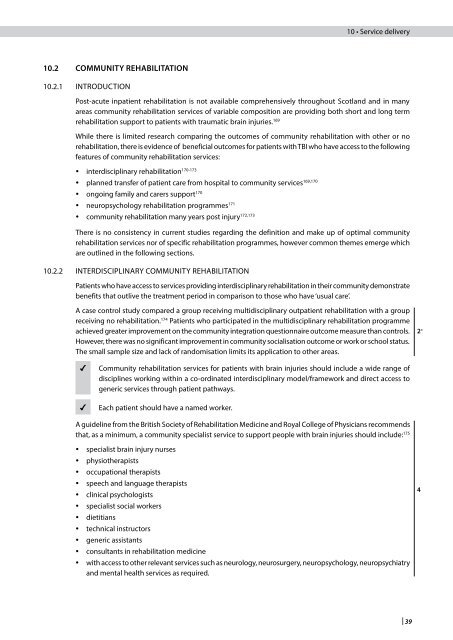sign130
sign130
sign130
Create successful ePaper yourself
Turn your PDF publications into a flip-book with our unique Google optimized e-Paper software.
10.2 CoMMuNITy REHABIlITATIoN<br />
10.2.1 INTRODUCTION<br />
Post-acute inpatient rehabilitation is not available comprehensively throughout Scotland and in many<br />
areas community rehabilitation services of variable composition are providing both short and long term<br />
rehabilitation support to patients with traumatic brain injuries. 169<br />
While there is limited research comparing the outcomes of community rehabilitation with other or no<br />
rehabilitation, there is evidence of beneficial outcomes for patients with TBI who have access to the following<br />
features of community rehabilitation services:<br />
y interdisciplinary rehabilitation170-173 y planned transfer of patient care from hospital to community services169,170 y ongoing family and carers support170 y neuropsychology rehabilitation programmes171 y community rehabilitation many years post injury172,173 There is no consistency in current studies regarding the definition and make up of optimal community<br />
rehabilitation services nor of specific rehabilitation programmes, however common themes emerge which<br />
are outlined in the following sections.<br />
10.2.2 INTERDISCIPLINARy COMMUNITy REHABILITATION<br />
Patients who have access to services providing interdisciplinary rehabilitation in their community demonstrate<br />
benefits that outlive the treatment period in comparison to those who have ‘usual care’.<br />
A case control study compared a group receiving multidisciplinary outpatient rehabilitation with a group<br />
receiving no rehabilitation. 174 Patients who participated in the multidisciplinary rehabilitation programme<br />
achieved greater improvement on the community integration questionnaire outcome measure than controls.<br />
However, there was no significant improvement in community socialisation outcome or work or school status.<br />
The small sample size and lack of randomisation limits its application to other areas.<br />
Community rehabilitation services for patients with brain injuries should include a wide range of<br />
disciplines working within a co-ordinated interdisciplinary model/framework and direct access to<br />
generic services through patient pathways.<br />
Each patient should have a named worker.<br />
10 • Service delivery<br />
A guideline from the British Society of Rehabilitation Medicine and Royal College of Physicians recommends<br />
that, as a minimum, a community specialist service to support people with brain injuries should include: 175<br />
y specialist brain injury nurses<br />
y physiotherapists<br />
y occupational therapists<br />
y speech and language therapists<br />
y clinical psychologists<br />
y specialist social workers<br />
y dietitians<br />
y technical instructors<br />
y generic assistants<br />
y consultants in rehabilitation medicine<br />
y with access to other relevant services such as neurology, neurosurgery, neuropsychology, neuropsychiatry<br />
and mental health services as required.<br />
| 39<br />
2 +<br />
4


